
The Open Ellipse
In DarkStar13 we looked at the instability of the intruder planet's orbit, and how it could be perturbed over time. The computer simulations conducted by Hills simulated the effect on our solar system of the intrusion of a massive planet or brown dwarf. His findings showed that a 'planet' as big as 10 Jupiter masses would not affect the stable orbits of the known planets. But the intruder could find itself flung out of the solar system, or enter a new, highly eccentric orbit. This elliptical orbit could vary over time as well, and would take the form of an eccentric 'open ellipse'. I proposed that this situation reflects what may have happened to Nibiru as it was perturbed from a great circular orbit several million years ago, and its current highly eccentric orbit is also unstable.
This might allow us to explain why Nibiru's orbital period has become unpredictable over time, and no longer seems to correlate at all well with the 3600 years described by the Sumerians. If Nibiru was the Messianic Star, then its last orbital period was certainly over 3700 years, and could be as great as 3784 years (Seneca's red Sirius account from 25 AD is the latest possible date for the appearance of the Messianic Star). This would indicate that the orbit of the dark star is slowly becoming larger, and this is in keeping with the idea of the 'open ellipse' shape. The Sun is slowly loosening its grip upon the dark star, and Nibiru will eventually cease to reappear in the planetary zone. This possibility might account for the disappearance of the Anunnaki from our world, given their understandable reluctance to find themselves stranded here.
When considering these ideas, it is important to back up these claims with some evidence from the ancient accounts. Even though my studies are still young, the evidence is already coming to hand in the form of quixotic spiral diagrams. The 'open ellipse' and 'screw-shaped' motifs appear to be fairly common, and mystify researchers.
Spiral Diagrams
We have seen how the Dogon's 'Nommo Star' apparently makes an appearance in the skies of Earth, and how Nibiru's visible perihelion passage past Sirius allows us to integrate this mythology with the 12th Planet theory.

In Robert Temple's revised 1998 edition of his book 'The Sirius Mystery', he includes vortex-like diagrams by a 'neighbouring tribe of the Dogon showing the Earth...with indications of spinning above and below'.
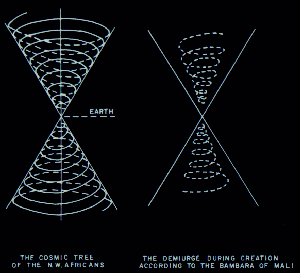
As Temple wrote in a foot-note to Appendix VII:
"They call it the 'Cosmic Tree'. The Bambara Tribe of Mali, immediate neighbours and cousins of the Dogon, and whose culture is also based upon the secret Sirius Mystery knowledge, draw a similar diagram... This information was left out of the original edition of The Sirius Mystery by the publisher, and I have restored it, as I think readers will find it interesting. Like so much which concerns the advanced knowledge preserved by these tribes, it would repay much further and deeper investigation." (1)
I suspect these vortex-like patterns pertain to the orbit of the Nommo Star from the point of view of Earth, and describe the changes of the 'bond Heaven-Earth'. Was this the explanation given to the Dogon as to why their gods had to depart from the Earth?
The Mali tribes have maintained ancient knowledge that has been lost or distorted by more 'mainstream' ancient cultures over time. Thus their drawings and explanations appear to bridge the divide between our modern understanding and the beliefs of the ancients.
The past appears to be talking to us directly, and is truly puzzling. The significance of the dark star's orbit is certainly great enough to account for these unusual motifs.
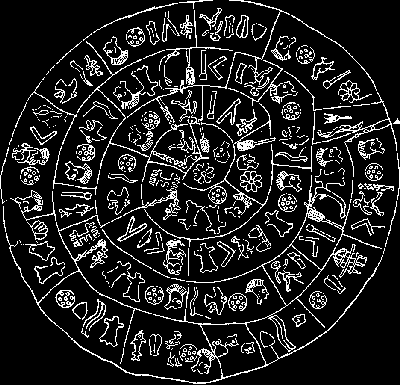
The Dogon are by no means the only ancient peoples to highlight the significance of the spiral shape. In fact, if Nibiru’s orbital pattern was indeed an open ellipse, signifying a changing, unstable orbit, then such a schematic representation should appear generally. We are not to be disappointed, more so because it is unclear as to why this particular shape held such importance among diverse cultures:
“We must not overlook the fact that not only the Sumerians, Akkadians and Chaldeans but also, and much earlier (sic), the wise men of Tiahuanaco, thanks to procedures of which we know nothing, had grasped that the heavenly path of the stars is an open ellipse, and this knowledge they transferred to their stone drawings and engravings… For the Chaldeans there was the god who held a staff in his hand, which was a double screw-shaped sceptre, the symbol of fertility and health. In the graves of the Kurgans in southern Russia, one found also screw-shaped tubes and spiral-shaped ear pendants.” (2)
Another famous example is the 'Phaistos Disc' (left), a Cretan relic that dates from about 1600BC. It is inscribed with indecipherable ideograms, 'arranged in a left-handed spiral motif'. To complete the picture, the disc contains a 'fire-bird', reminiscent of the Phoenix, and the star constellations of Serpens (aphelion position) and Pisces (Age of last passage), as well as the Pleiades (or the 7 stars of the Nibiru system?), and the Quaz, 'the Egyptian symbol of physical and spiritual strength' (2). Taken together, we can see how the enigmatic Phaistos Disc can be interpreted by the Dark Star mythology, and how it points us in the direction of an open ellipse for its orbit.
This unusual motif seems to crop up in various places in the ancient world, as so many other common factors that bind the ‘insular’ civilisations of the ancient world together. More modern esoteric knowledge includes similar symbolism, although often denoted by serpents wrapped around trees and the like.
The Winged Disc seems to offer a catalyst for breaking these codes, and understanding the astronomical knowledge of the ancients.
Red Star Marduk
Through the course of this web-site, I have explored the various potential images of the brown dwarf and its moons. The standard image of the 'winged disc', Horus Horakhti, is a stylised representation of the 12th Planet, known as Nibiru to the Sumerians and Marduk to the Babylonians. The Babylonians described the celestial god Marduk as a wandering 'red star' in their astrolabe, and this reference directly contradicts the opinion of some scholars that Marduk represented Jupiter, which is a white planet as it appears from Earth.
It is well known that the Babylonian knowledge of astronomy was well advanced for its time. Harris cites Babylonian quotations about their god Marduk, and highlights their crystal-clear understanding of the god's astronomical identity (3). The first is from a Babylonian astrolabe:
"The red star, which when the stars of the night are finished, bisects the heavens and stands there whence the south wind comes, this star is the god Nibiru-Marduk" (4)
One might assume that this reference was to a planet of red colour, which would have to be Mars. But Marduk is in no way connected with Mars, rather with a more 'lordly' planet, generally taken to mean Jupiter. However, Jupiter clearly appears as a white planet, not a red one. Marduk is not correspondent with Jupiter in any of the myths, either. Thus we have an anomalous red star that moves through the heavens in an unusual way. The reference is to an early morning celestial event, when the Sun would be rising in the east. Yet, Nibiru/Marduk is ‘bisecting the heavens and standing whence the south wind comes’. It thus appears to be off the ecliptic, and low in the southern celestial hemisphere, just as I have indicated for the brown dwarf’s perihelion in the planetary solar system.
Brown dwarfs, as recent photos from the Hubble Space Telescope indicate, appear red. The Babylonians included a similar reference in a star-list called the “12 stars of Elam, Akkad and Amurru”. Whilst one recognises the importance Sitchin places upon the 12 ‘planets’, this is a star-list, seemingly differentiating Nibiru/Marduk from the known planets, and denoting its star-like properties:
"When the stars of Enlil have disappeared the great faint star, which bisects the heavens and stands, is Marduk-Nibiru SAG.ME.GAR; he (the god) changes his position and wanders over the heavens.” (4)
One must ask oneself what the Babylonians were referring to when describing a ‘great faint star’. This appears to be a contradiction in terms, until one understands the orbital properties of Nibiru. This ‘planet’, or brown dwarf as I have proposed, cannot be seen for the vast majority of its long motion around the Sun. Yet it is the ‘Lord’ of the ancient world in Mesopotamia, the very source of their gods. As it first becomes visible, moving from the Great Bear through Cancer, it is quite faint. It is not until it arrives at the Duat that its countenance can be properly appreciated, and its moons become visible to observers on Earth. Its greatness was praised over all other cosmic objects, including the Sun. In this context, the quote readily makes sense. Marduk's wanderings through the lands has a celestial counterpart, in the same way that Bauval has shown that the Pyramids at Giza have a celestial counterpart in the skies, in the belt of Orion (5). Sitchin quotes the account of the wanderings of Marduk:
"O great gods, learn my secrets
as I girdle my belt, my memories recall.
I am the divine Marduk, a great god.
I was cast off for my sins,
to the mountains I have gone.
In many lands I have been a wanderer;
From where the Sun rises to where it sets I went." (6)
Marduk's inclusion of the secrets of the 'belt', and wandering through the mountains indicate the celestial equivalent of the Pyramids of Giza, in much the same way as Bauval's interpretation. The red star Marduk thus wandered through the heavens, through the belt of Orion, and the Pyramids stand testament to that celestial phenomenon. Sitchin also quotes scholars who draw parallels between the god Marduk and the Christ figure, particularly bearing in mind Marduks' entombment and 'subsequent reappearance to become the dominant deity' (4). But he seems less than keen to explore this idea in detail. However, it is clear to me that the Messianic tradition is fundamentally related to the advent of Christianity, although the message of that religion has been drastically altered since the 1st Century A.D.
The Hebrew Star
Evidence that the Christian message originated from a celestial phenomenon can be found in Apocryphal texts that were excluded from the New Testament, as well as Old Testament prophecies and some of the Dead Sea Scrolls. This passage contains a stirring description of the anomalous ‘star’, and the effect that it had on those gazing upon it, and one wonders whether this description is of the same phenomenon noted by Seneca:
"How then was our Saviour manifested to the world? A star shone in heaven beyond all the other stars, and its light was inexpressible, and its novelty struck terror into men's minds. All the rest of the stars, together with the sun and moon, were the chorus to this star; but that sent out its light exceedingly above them all. And men began to be troubled to think whence this new star came, so unlike to all the others."
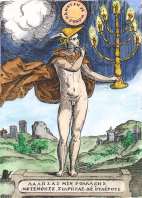
The appearance of Nibiru and its 7 moons would indeed have struck fear into the hearts of men, particularly given the association of this ‘star’ with calamities in the past. During the Messianic Era, Nibiru, a brilliant red dark star, with a contingent of visible moons, appeared in the sky close to Sirius, as it progressed through perihelion in the Duat (DarkStar 8).
It seems to have appeared at the wrong time of year for the people
of that time to have observed it’s full movement across the heavens (probably
during Spring when Sirius begins to dip below the horizon), but its brief
appearance during the Messianic Era was enough to fuel great excitement
regarding the imminent appearance of the Messiah.
The belief in a Rising King connected with
the appearance of a star had roots in Messiah prophecies in the Old Testament.
The first of these was the ‘star prophecy’ in Numbers, in the oracle of
Balaam:
“I see him, but not now;
I behold him, but not near;
A star shall come forth out of Jacob,
A comet shall arise from Israel.
He shall smite the squadrons of Moab,
and beat down the sons of strife.” Numbers 24: 17
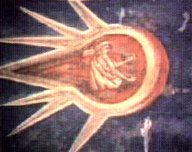
This famous prophecy describes a hidden star that is also a comet, and optimistically describes how its future arrival will bring woe upon the enemies of Israel. Baigent and Leigh make use of a slightly different translation for this passage from Numbers, and show how this celestial phenomenon becomes the figure of Christ:
“The advent of the ‘Messiah’ is stated as having been prophesied in Numbers 24:17, where it is said that ‘a star from Jacob takes the leadership, a sceptre arises from Israel’. The ‘Star’ thus becomes a sobriquet for the ‘Messiah’, the regal warrior priest-king who will lead the forces of Israel to triumph.” (7)
The second prophecy is in the last book of the Old Testament, Malachi, regarding a “sun of righteousness”:
“The day comes, glowing like a furnace; all the arrogant and the evildoers shall be chaff, and that day when it comes shall set them ablaze, says the Lord of Hosts, it shall leave them neither root nor branch. But for you who fear my name, the sun of righteousness shall rise with healing in his wings, and you shall break loose like calves released from the stall.” Malachi 3: 1-2
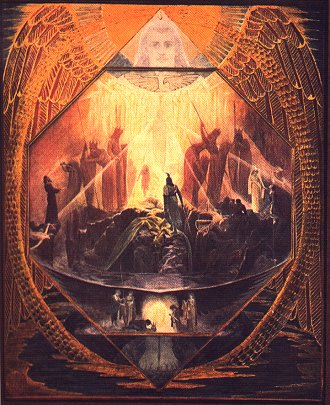
Of interest to us is the discussion of the 'wings' of the Sun of Righteousness, a quote that seems to directly refer to the Winged Disc (11). This passage describes the coming Armageddon , and the resurrection of the righteous through the advent of this 'Winged Sun'.
These messianic prophecies have clear celestial overtones which are in keeping with the appearance of a Messianic Star. Baigent and Leigh have shown that the Dead Sea Scrolls contain references to a Messiah figure known to the Qumran community (5).
The Roman Catholic Church has been embarrassed by the apparently generalised belief in a Christ-like figure at that time. A review of the so-called Qumran ‘War Scroll’ indicates that the Messianic figure was warrior-like, and would deliver the Hebrew people from their Roman oppressors. Regarding the connection of a ‘Star’ and the Messianic warrior priest-king, Baigent and Leigh make this point:
“As Robert Eisenman has stressed, this prophecy linking the Messiah figure with the image of the star occurs elsewhere in the Qumran literature, and is of crucial importance. It is also significant that the same prophecy is cited by sources quite independent of both Qumran and the New Testament – by historians and chroniclers of 1st-century Rome, for example, such as Josephus, Tacitus and Suetonius.” (7)
It is interesting to note the references to the military stance of the ‘Messiah’, and the arrangement of his ‘troops', given in the ‘War Scroll’ of the Qumran community:
“Seven troops of horsemen shall also station themselves to right and to left of the formation; their troops shall stand on this side…” (7)
This helps to explains the significance of the seven stars in Hebrew symbolism, which appears in the image of the early Christian 'Talisman of Orpheus' (DarkStar9). That this reference comes from one of the Dead Sea Scrolls, documents that have not been tampered with down the ages, makes it potentially significant in our quest to uncover the true nature of the Messianic Star. Finally, here is a quote form an apocryphal text that cites the knowledge Jesus had about astronomy:
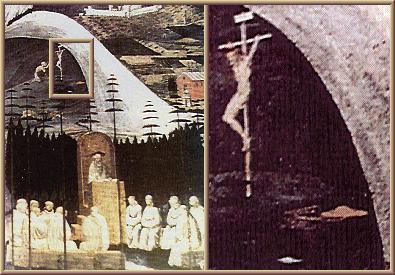
A red 'Flying Saucer' at the
crucifixion, or a pictoral representation of the Messianic Winged Disc?
(9)
“When a certain
astronomer, who was present, asked the Lord Jesus, whether or not he had
studied astronomy? The Lord Jesus replied, and told him the number of the
spheres of the heavenly bodies, as also their triangular, square, & sextile aspect; their progressive & retrograde motion; their size &
severa, prognastictions; & other things which the reason of Man had
never discovered...” (8)
One must ask, which of the 'spheres of the heavenly bodies' was retrograde? Certainly none of the known ones, although Mars is sometimes seen to 'backtrack' under certain conditions.
But the allusion to 'other things which the reason of Man had never discovered' indicates that Jesus was privy to secret knowledge, and one wonders whether the retrograde motion of an anomalous celestial object was thus central to his teaching. If Nibiru was the Messianic Star, then this was almost certainly the case, and the teachings of Early Christianity had very ancient allegorical meaning attached to them.
Taken together, the above textual quotes from Hebrew literature build up a picture of the importance of a hidden, winged 'sun' to the Messianic tradition, and how this celestial apparition is central to the belief in the coming Apocalypse and resurrection of Christians. I propose that these concepts are inherently connected with the ancient knowledge of the brown dwarf Nibiru, and the gods that created Mankind.
Written by Andy Lloyd, 16th February 2001
author of 'The Dark Star' (2005), 'Ezekiel One' (2009), 'The Followers of Horus' (2010) and 'Darker Stars' (2019)
Published by Timeless Voyager Press
References
1) Robert Temple “The Sirius Mystery: New Scientific Evidence of Alien Contact 5,000 Years Ago” Appendix VII, pp394-6,Century 1976
2) Peter Kolosimo “Timeless Earth” pp176, 226-7 Sphere 1974
3) J. Harris “The Star of Bethlehem and Babylon” 1996
4) B. Van der Waerden “Science Awakening II” pp66-68 Oxford University Press 1974
5) Robert Bauval and Adrian Gilbert "The Orion Mystery: Unlocking the secrets of the pyramids" p202 Mandarin 1994
6) Zecharia Sitchin "When Time Began" p334, 356 Avon 1993
7) Michael Baigent & Richard Leigh "The Dead Sea Scrolls Deception" pp213-4 Corgi 1991
![]() The Dead Sea Scrolls Deception
The Dead Sea Scrolls Deception
8) 'Serp' “Nibiru” quoting; “The Lost Books Of The Bible” Gramercy Books
9) "Historical Artwork & UFO's" Matthew Hurley
10) O.Hagen "The Minoan Calendar"
11) A correspondent named Daniel Baggett points out the following regarding Hebrew textual quotations:
"For centuries the "Christian church" has attempted to understand HEBREW Scriptures from a Western-Greek mindset [All non-Hebrews suffer from this malady]. One cannot understand the Scriptures by doing so. The Scriptures were written by HEBREWS to HEBREWS and use what is called Hebraisms...sayings which mean something other than what is read/said. For instance in your above referenced quote from Malachi chapter 3 it is well known among Hebrews that the "wings" mentioned referred to the corners of the Hebrew tallit...a prayer shawl.
"The woman with the issue of blood which we read about in Mark chapter 5 knew the Tanak/Old Testament. Specifically the prophecy of Malachi 3, and knew also that if this was the promised Messiah i.e. the "sun of righteousness" then she would be healed when she touched his "wings"! The "sun of righteousness" is a reference to Messiah. "A day with the Master/Lord is as a thousand years and a thousand years is as a day": It was in the 4th day of creation [Genesis chapter 1] (fourth 1,000 year period of man) when the "sun" (Messiah) appeared.
"Messiah had to appear/be born in the 4,000th year period to qualify as the Saviour of all Israel. Also, in prophecy the foretold events are very often NOT in chronological order. YHVH often interspersed far future events right in the middle of what was being prophesied for immediate fulfilment."
August 2008